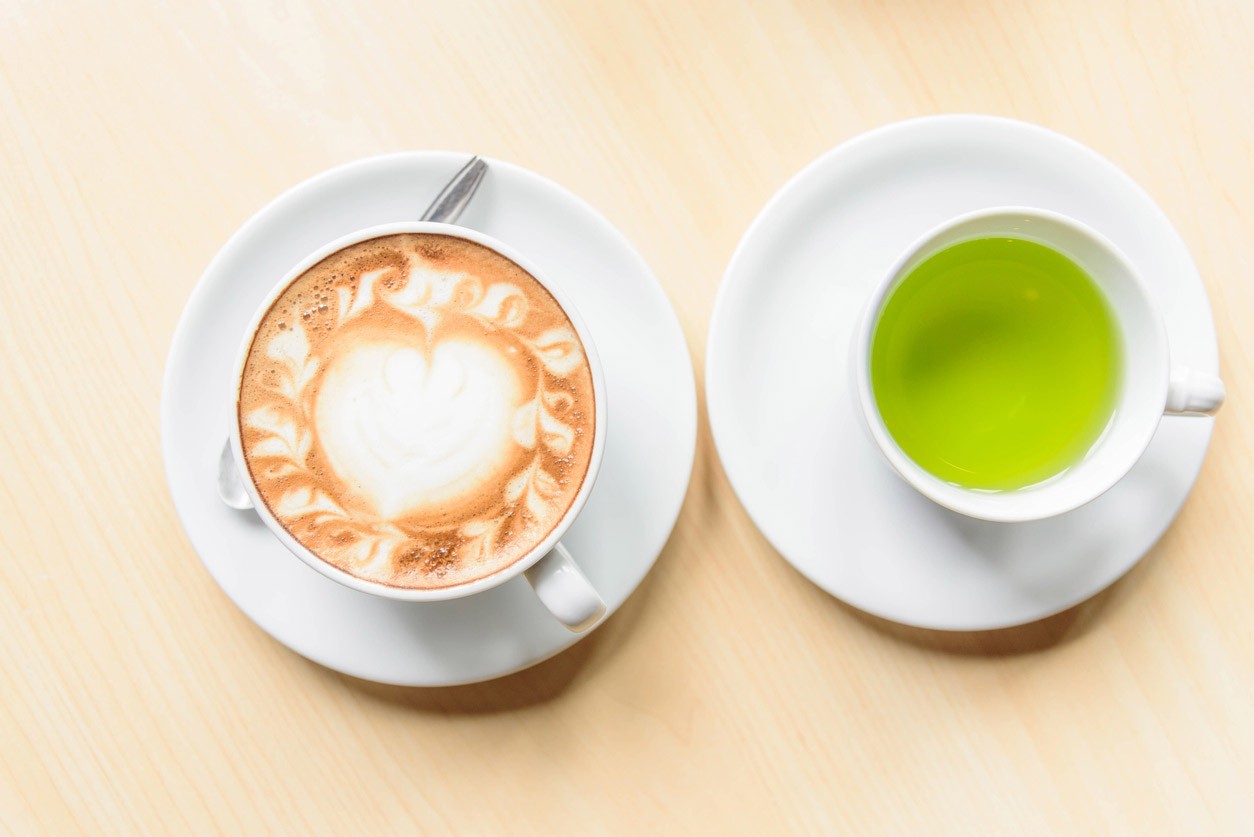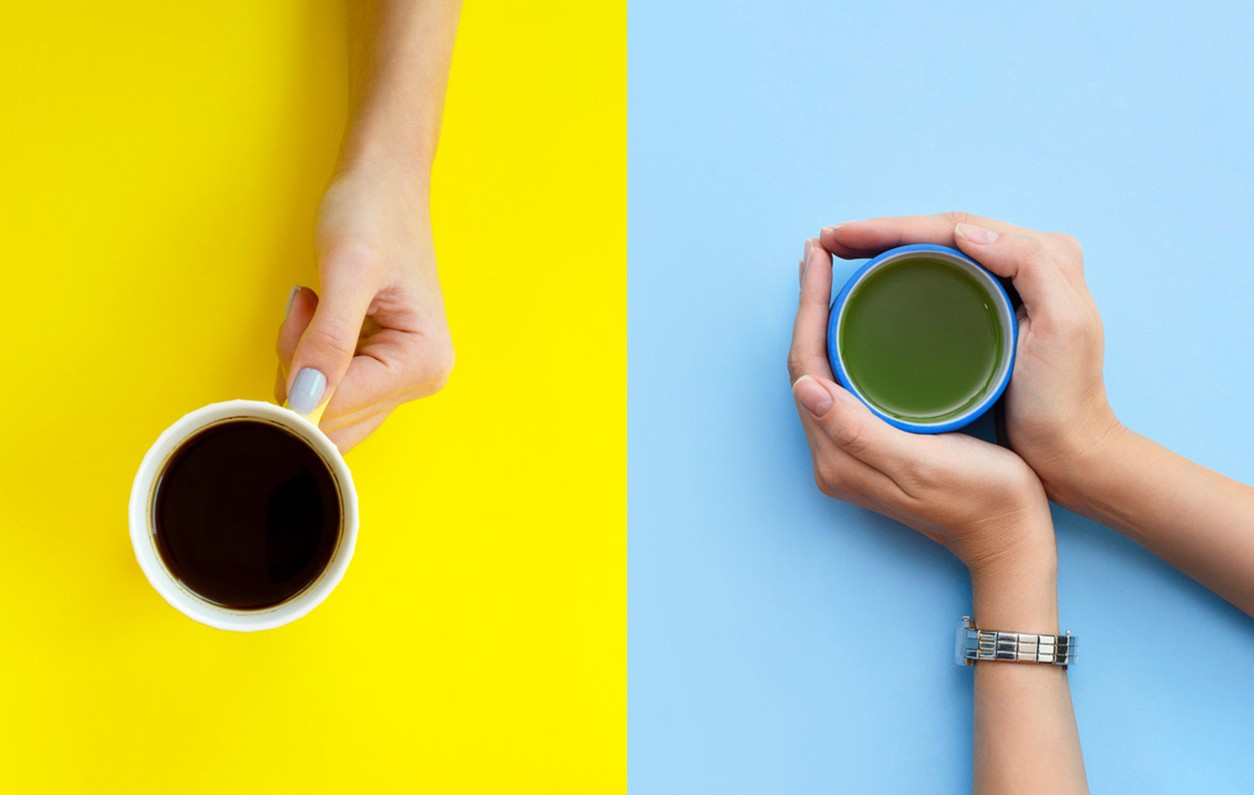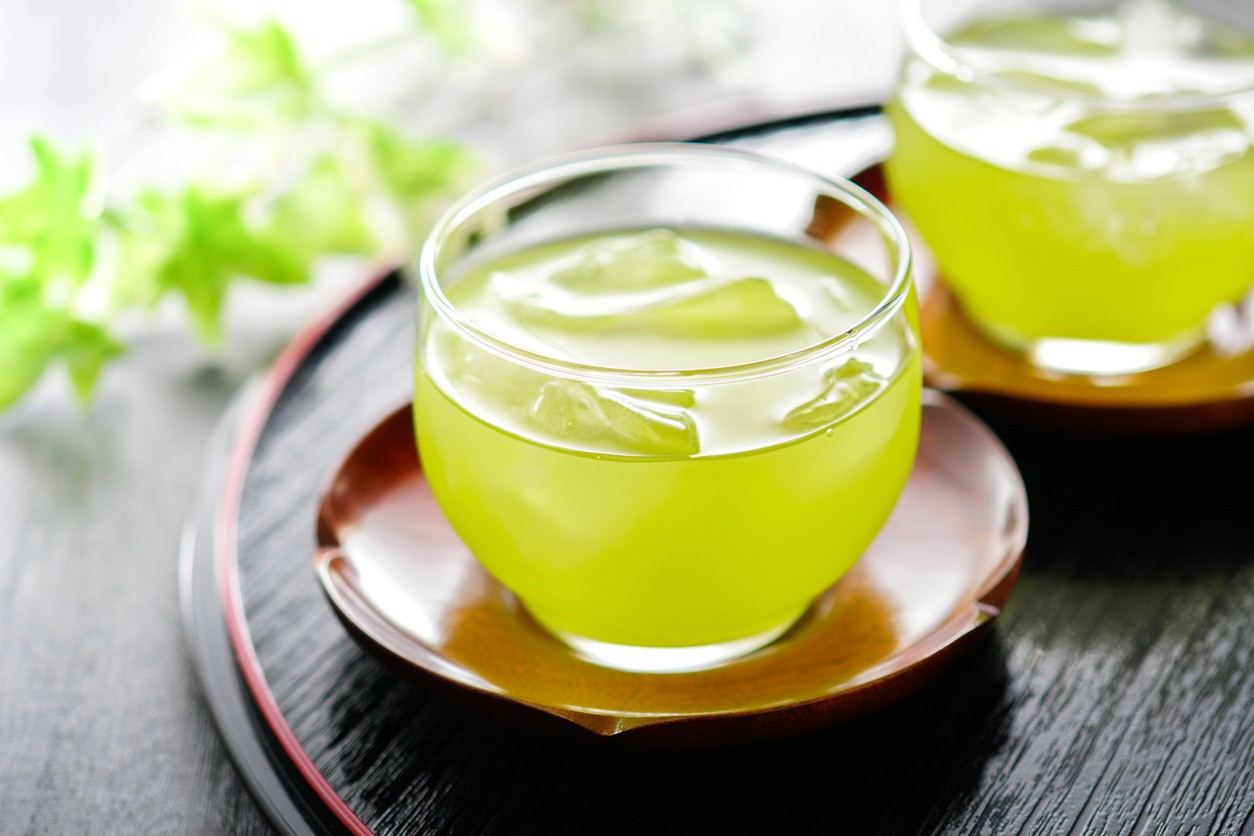Caffeine content in coffee compared to green tea is a frequent concern, especially for those seeking an energy boost. COMPARE.EDU.VN offers a comprehensive comparison, detailing the caffeine levels in each beverage and exploring the factors that influence them. By understanding these nuances, you can make an informed choice that aligns with your desired energy levels and health goals. Explore caffeine alternatives and beverage comparisons for informed decisions.
1. Caffeine Content: Coffee vs. Green Tea
Coffee generally has more caffeine than green tea. However, many factors influence the caffeine content in both beverages, leading to potential variations. Understanding these elements is crucial for comparing them accurately.
Which Beverage Contains More Caffeine: Green Tea or Coffee?
Typically, coffee contains more caffeine than green tea. According to the FDA estimates, an 8-ounce cup of coffee usually has between 80 and 100 mg of caffeine. Conversely, an 8-ounce cup of green tea usually contains 30 to 50 mg of caffeine.
However, caffeine content varies significantly based on factors in both tea and coffee. Certain coffee varieties have higher caffeine levels, just as certain teas naturally contain more caffeine than others.
Factors Affecting Caffeine Content in Green Tea
Several elements influence the amount of caffeine in green tea:
- Tea Variety: The specific type of green tea significantly affects its caffeine content. For example, Gyokuro typically has more caffeine than Sencha.
- Harvest Time: Early harvests usually have higher caffeine content because younger leaves contain more caffeine.
- Water Temperature: Higher water temperatures extract more caffeine during brewing.
- Steeping Time: Longer steeping times result in higher caffeine extraction.
- Brewing Method: Cold-brewing extracts less caffeine compared to hot brewing. Iced tea prepared with hot water before chilling will still have the same caffeine level as hot tea.
Based on analyses by Eurofins Scientific Inc.
Factors Affecting Caffeine Content in Coffee
The caffeine level in coffee is influenced by the following factors:
- Coffee Species and Grind Size: Arabica beans generally have less caffeine than Robusta beans. Finer grinds release more caffeine during brewing.
- Brewing Method: Brewed coffee often has more caffeine per serving compared to espresso. This is considering standard serving sizes: 8 ounces for brewed coffee vs. 1 ounce for espresso.
- Coffee Amount: Using more coffee grounds results in a higher caffeine content in the final brew.
- Brewing Time: Longer brewing times extract more caffeine from the coffee grounds.
- Water Temperature: Higher water temperatures extract more caffeine. Cold-brewed coffee will naturally have less caffeine.
Decaffeinated Green Tea vs. Decaffeinated Coffee
While decaf coffee is widely available, decaf green tea is less common. Neither is completely caffeine-free. Decaffeination processes reduce caffeine content, but usually leave 5% to 15% of the original caffeine levels.
2. Adaptability: Versatility in Drink Recipes
Both green tea and coffee are versatile ingredients for various drink recipes, lending themselves to hot, cold, alcoholic, and milk-based beverages.
Hot Drinks: Tea-Based and Coffee-Based
- Traditional Preparations: Green tea and coffee can be prepared with hot water, served with milk or sweeteners. Coffee has a wide variety of brewing methods, like using an espresso machine or French press. Likewise, tea boasts varied brewing techniques, including gaiwan brewing and matcha whisking.
- Café-Style Drinks: Both beverages are used as the foundation for many café-style drinks. Coffee features in lattes, cappuccinos, and affogatos. Green tea is equally adaptable, starring in matcha lattes and affogatos. Asian-inspired drinks, like milk tea, also showcase tea’s versatility.
Cold Drinks: Refreshing Tea and Coffee Options
Both green tea and coffee can be enjoyed cold, whether served over ice or blended into a refreshing frappuccino. Cold-brewing is a common method for both, creating a less acidic and smoother beverage.
Alcoholic Drinks: Spiked Coffee and Green Tea Creations
Coffee and green tea are finding their way into cocktails, shots, and infused liquors. Coffee classics include the Espresso Martini, while green tea stars in the Green Tea Martini. Liquors like Bailey’s Irish Cream and Kahlua highlight coffee, while Roku gin and Suntory’s Kanade Matcha liqueur feature green tea.
3. Preparation Methods: Unique Brewing Techniques
Green tea and coffee offer diverse preparation methods, each with its own unique process and cultural significance.
Green Tea Preparation
Brewing loose-leaf teas and tea bags is a common way to prepare green tea, with unique methods like gaiwan brewing, bowl brewing, and matcha whisking from Eastern cultures.
Coffee Preparation
A variety of ways exist for coffee, such as espresso machines, Aeropress, and Moka Pots. Coffee brewing methods are often tied to specific cultures, exemplified by “Turkish sand coffee,” where hot sand is used for heating.
Cold Brewing
The cold brewing process is similar for both coffee and green tea. The tools are essentially the same, with slight differences in steeping time.
4. Culture: Evolving Traditions
Both coffee and green tea have dynamic cultures that continue to evolve.
- Green tea, particularly Japanese green tea, is associated with culture, tradition, health, and wellness.
- Coffee is tied to social aspects, with changes in response to consumer values and buying behavior.
Modern Green Tea Culture
Green tea culture has two main aspects:
- Growing Popularity of Green Tea, Particularly Matcha:
- In the marketplace: Matcha is in food, beverages, and skin care products. Matcha and green tea lattes are becoming alternatives in coffee shops.
- On social media: Matcha dominates on social media with millions of posts.
- Modernization of Green Tea Consumption: Green tea consumption is no longer confined to ceremonies. Japanese tea producers are adapting to younger consumers.
Modern Coffee Culture
Modern coffee culture has four aspects:
- Coffee as a productivity booster: Coffee is essential for productivity, as shown by coffee chains and coffee machines in workplaces.
- Personalization: The market has shifted to many beverage options and specialty coffee products.
- Drinking coffee as a social event: Coffee shops are popular hangout spots.
- Third-wave/specialty coffee: With sustainability and mindful consumption, the third-wave movement supports ethical practices and mindful consumption.
Green tea and coffee offer benefits like increasing energy levels and providing health advantages.
Comparing the Caffeine Levels of Coffee and Green Tea
To provide a clear comparison, consider this table outlining the average caffeine content in various types of coffee and green tea:
| Beverage | Serving Size | Caffeine Content (mg) |
|---|---|---|
| Brewed Coffee | 8 oz | 80-100 |
| Espresso | 1 oz | 63 |
| Instant Coffee | 8 oz | 30-90 |
| Green Tea (Sencha) | 8 oz | 30-50 |
| Green Tea (Matcha) | 8 oz | 70 |
| Green Tea (Gyokuro) | 8 oz | 60 |
| Decaf Coffee | 8 oz | 2-12 |
| Decaf Green Tea | 8 oz | 2-5 |
| Cold Brew Coffee | 8 oz | 100-200 |
| Cold Brew Green Tea | 8 oz | 20-40 |



Health Benefits and Considerations
While caffeine provides alertness, it is crucial to consider the health benefits and potential drawbacks of both coffee and green tea:
- Coffee: Rich in antioxidants and may improve mental function. It can also increase blood pressure and cause anxiety in some individuals.
- Green Tea: High in antioxidants, supports heart health, and may have anti-cancer properties. It offers a more sustained energy release due to L-theanine, which promotes relaxation.
Finding the Right Balance: Coffee vs. Green Tea for You
The choice between coffee and green tea depends on individual preferences and needs. Consider these points:
- Desired Energy Level: Coffee provides a stronger and more immediate energy boost.
- Sensitivity to Caffeine: Green tea offers a gentler effect, ideal for those sensitive to caffeine.
- Health Goals: Both offer health benefits, but green tea’s antioxidant properties are particularly noteworthy.
Expert Opinions on Caffeine Consumption
Health experts often advise moderation in caffeine intake. According to Mayo Clinic, up to 400 milligrams of caffeine a day appears to be safe for most healthy adults. This is roughly the amount of caffeine in four cups of brewed coffee, 10 cans of cola or two “energy shot” drinks.
Research Findings on Coffee and Green Tea:
- A study published in the Journal of Alzheimer’s Disease found that coffee consumption was associated with a decreased risk of cognitive decline.
- Research in the American Journal of Clinical Nutrition indicated that green tea consumption might lower the risk of cardiovascular disease.
Deciding Between Coffee and Green Tea: A Personal Choice
Choosing between coffee and green tea ultimately depends on your personal preferences, caffeine tolerance, and health goals. Understanding the caffeine content and benefits of each will help you make an informed decision.
Optimize Your Choice with COMPARE.EDU.VN
Making a decision between beverages doesn’t have to be difficult. Use COMPARE.EDU.VN to compare green tea and coffee for caffeine content, health benefits, and taste.
5. Frequently Asked Questions (FAQs)
Q1: Does the type of coffee bean affect caffeine levels?
A1: Yes, Arabica beans generally have lower caffeine content than Robusta beans.
Q2: How does steeping time influence the caffeine in green tea?
A2: Longer steeping times extract more caffeine from the tea leaves.
Q3: Is cold-brewed coffee always lower in caffeine?
A3: Yes, because lower temperatures extract less caffeine.
Q4: Can green tea provide the same energy boost as coffee?
A4: While it contains less caffeine, the presence of L-theanine in green tea offers a more sustained energy release without the jitters.
Q5: Are there any downsides to drinking coffee daily?
A5: Excessive coffee consumption can lead to increased blood pressure, anxiety, and insomnia in some individuals.
Q6: What are the health benefits of drinking green tea regularly?
A6: Regular green tea consumption is associated with improved heart health, anti-cancer properties, and enhanced mental alertness.
Q7: How does matcha compare to other green teas regarding caffeine content?
A7: Matcha usually has a higher caffeine content than other green teas due to the consumption of the entire leaf powder.
Q8: Can the brewing method significantly change the caffeine content in coffee?
A8: Yes, brewing methods like espresso and drip coffee result in different caffeine concentrations per serving.
Q9: What is L-theanine and how does it affect caffeine?
A9: L-theanine is an amino acid that promotes relaxation and can mitigate the negative side effects of caffeine, such as anxiety.
Q10: Where can I find more detailed comparisons of beverages like coffee and green tea?
A10: For more detailed comparisons and insights, visit COMPARE.EDU.VN, your go-to source for objective and thorough analyses.
Finding the right beverage to match your energy needs and health preferences can be easier with the right resources. COMPARE.EDU.VN offers detailed comparisons to help you decide.
Are you on Team Green Tea? Check out our wide range of high-quality Japanese green teas!
Likewise, if you’re unsure of which green tea would be great for you, feel free to contact us to learn more. You can also check out our samplers, which can give you a taster of different Japanese green teas for one price.
Making informed decisions about your beverage choices is crucial for your health and well-being. At COMPARE.EDU.VN, we provide comprehensive comparisons and reliable information to help you make the best choices. Visit us at 333 Comparison Plaza, Choice City, CA 90210, United States or contact us via Whatsapp at +1 (626) 555-9090. Learn more at compare.edu.vn and make informed decisions today.
Disclaimer: Please note that this post is intended to provide information and shouldn’t be taken as medical advice. Additionally, any information in this post and any linked posts shouldn’t be used to replace professional medical advice or treatment.